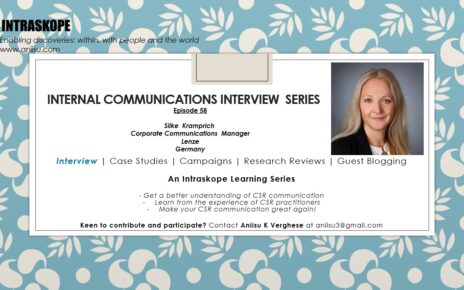Is ChatGPT a bane or a boon for internal communicators? Is this going to sound the death knell for many occupations? What must professionals in creative fields do to stay relevant?
The explosion of AI tools and platforms is putting many occupations in jeopardy. Especially for communications, marketing, media, and branding professionals, there are significant shifts in how the functions are perceived, will be practiced, and programmed in the future.

From crafting grammatically accurate and logical messages to drafting plans and proposals; from generating FAQs to ideating approaches for stakeholder engagement, the power of tools like ChatGPT is immense. That also challenges the very existence of professionals and their roles.
Why must leaders and organizations rely on communicators if, in a minute or two, they can create content, plans, and proposals for everyday and strategic practices, staff-facing channels, and people engagement?
Rather than watch from the sidelines, these tools offer a huge opportunity for communication professionals to appreciate what these trends mean to their everyday work and how they can be leveraged to enhance their roles and deliver added value for stakeholders.
According to the Expert Market Research study, the global artificial intelligence market value touched around USD 1.2 trillion in 2020. It will grow at a CAGR of about 23% in the forecast period of 2023-2028 to reach a value of about USD 6 trillion by 2026. According to the Gartner Hype Cycle, while natural language processing is listed under the ‘trough of disillusionment’ (tending downwards before moving up the Slide of Enlightenment and then the Plateau of Productivity), applications-centric AI is expected to flourish in the next 2 to 5 years providing significant business benefits. We are already seeing ChatGPT giving us a glimpse of the possibilities. We also hear of Google and Deepmind coming up with Sparrow, a ChatGPT competitor.
The Brookings organization predicted in 2018 that “AI is expected to be better equipped than humans to write a high school essay by 2026, drive a truck by 2027, work in retail by 2031, write a best-selling book by 2049, and perform surgery by 2053. There is a 50 percent chance AI will outperform all human tasks in 45 years and automate all human jobs in 120 years”. universities
I think these predictions are already a reality in some industries. Already Universities are reconsidering defaulting to paper and pen examinations to avoid unfair usage of tools like ChatGPT.
As AI and machine learning disrupt the world of work, workplaces, and workforces, people will need to unlearn and continually evolve their skills to stay relevant in the future. An analysis of 228 million job ads indicates that the fastest-growing and most needed skills are:
A) Artificial Intelligence (AI)/machine learning (ML)
B) Cloud computing
C) Product management
D) Social media
Just in 2021, the demand for these skills grew 122% as compared to just 10% for other skills, telling us a lot about what will be needed in the future. What’s more, Education 4.0, is defined as lifelong experience and learning as an always-on behavior and the 3 key skills needed for the future are problem-solving, collaboration, and adaptability.
The pace of change is also prompting governments to act. Governments and institutions are attempting to gain more control over the implications of these tools. From the AI Bill of Rights to the EU AI Act, which can be gold standards for regulatory and societal guardrails.
What does it all mean for internal communicators and other professionals in the creative fields?
- The good news is that ChatGPT or any other natural language processing tools are only as good as the prompts they get. As they continue to get better (or worse) depending on what’s fed into the system, the output will improve or deteriorate. This is where communicators have an advantage. Just like the questions you ask in real-life (for example, in engagement surveys, interviews, during leadership chats, conversations with staff etc), the quality of the responses depends a lot on what you ask. Understanding how the system functions and what will enable better responses is where communicators can play a key role.
- Just generating output from ChatGPT isn’t good enough because the tool spews out generic content. Also, not everything makes sense or is useful. Getting a basic draft does help avoid writer’s block which many of us would do anything to overcome! However, going from a basic draft to a ready ‘go-to-staff’ plan takes a lot more effort. Communicators add value with context, clarity, and connections. Finding ways to bridge understanding, and appreciating audience expectations and sentiments are approaches to take the output and make it work for successful communication and branding.
- A smarter way is to integrate ChatGPT into internal tools and platforms (after putting in checks and balances for privacy and data protection) and tap analytics and sentiments for enhancing communication. Nothing beats data and insights which can prove or disprove if your communication is making a difference or not.
- Upgrade your communication strategy by utilizing technology to improve and streamline content, systems, and practices. For instance, Chat GPT can be tapped to automatically create personalized employee updates, FAQs, and other types of internal communications which often take weeks if not months, and then goes through numerous reviews and iterations.
- Raise the profile of your internal knowledge systems by including natural language search capabilities if they don’t already have running. Those days of staff saying they can’t find what they need to do their work effectively should be a thing of the past!
- Identify barriers to effective communication using natural language and tools like ChatGPT. Often, communicators and leaders speculate about the reasons why the staff isn’t engaging in communication or why they aren’t responsive enough. Identifying areas of confusion and misinterpretation can reduce the amount of angst and rework that organizations invest time and resources in.
It isn’t going to be easy sailing through the turbulence organizations and communicators will face in the near term as these tools get more and more robust. There is an onus on communicators to take stock of their own skillsets and mindsets before investing in understanding these newer technologies – not just for themselves but for stakeholders.
With the democratization of such tools, occupations and roles that were, primarily, the stronghold of ‘qualified’ professionals, will be managed by anyone with the passion and commitment to learning and experimentation.
Like the article? Share your comments here.
Interested in similar content? Look up my blog www.aniisu.com and website www.intraskope.com
Keen to get advice on communication? Look it up here: https://www.intraskope.com/advantage
Here are Internal Communications resources you can use:
- Read Book | Internal Communications – Insights, Practices & Models (Sage Publications, 2012)
- Learn: Internal Communications Fundamentals Course on Thinkific
- Internal Communications Series: https://forms.gle/KcqmPzLwq7NQi5Km6
- Chat with Aniisu – Internal Communications: https://www.instamojo.com/intraskope/connect-with-aniisu-60-minute-personalized-d/?ref=store
- Internal Communications workshops: https://bit.ly/2zdBRl1
#ChatGPT #NLP #skills #futureskills #AI #artificialintelligence #cloud #cloudcomputing #internalcomms #IC #learning #technology #naturallanguageprocessing #productmanagement #socialmedia #hypecycle #gartner #expertmarketresearch #davos #weforum



